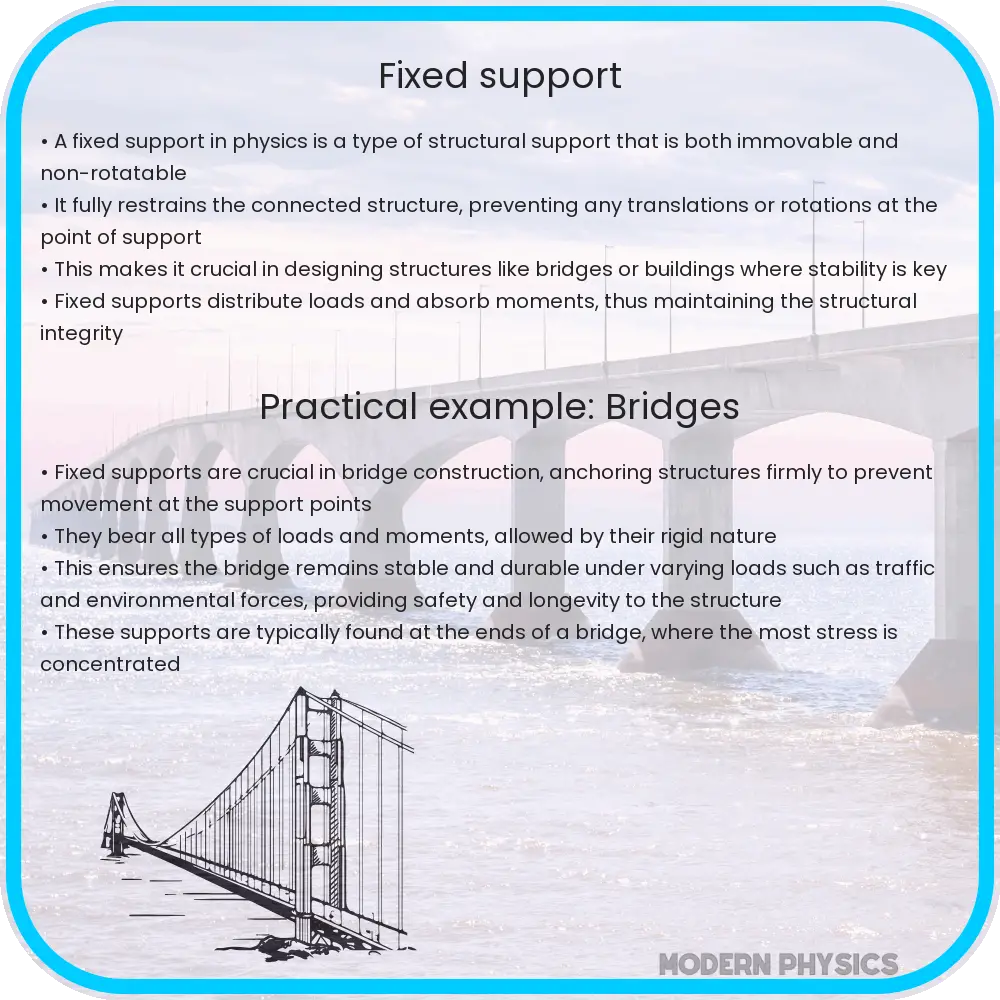Explore the crucial role of fixed supports in statics, their applications, challenges in design, and analysis techniques for structural stability.

Understanding Fixed Supports in Statics
Fixed supports play a crucial role in the field of statics, a branch of mechanics that deals with the study of bodies at rest or in motion with constant velocity. In engineering and architectural design, fixed supports are essential for ensuring structural stability and reliability. These supports are characterized by their ability to resist both rotational and translational movements, making them integral in various construction and mechanical applications.
At the core of fixed support systems is their ability to withstand forces and moments. Unlike other support types, such as roller or pinned supports, fixed supports can bear bending moments, shear forces, and axial forces. This multifaceted resistance makes them invaluable in structures that require a high degree of rigidity and stability.
Applications of Fixed Supports
Fixed supports are widely used in bridges, buildings, and large machines. They are particularly prevalent in structures that must endure significant environmental loads, such as wind or seismic activity. For example, in bridge construction, fixed supports are often employed at the ends of the bridge to anchor the structure firmly to the ground, providing resistance against various forces that the bridge might encounter.
Characteristics of Fixed Supports
A key feature of fixed supports is their immobility. They do not allow for any translational movement, meaning the supported structure cannot move up, down, or sideways. Additionally, these supports prevent any rotational movement, ensuring that the connected elements maintain their original orientation. This rigidity is critical in maintaining the structural integrity of a system under load.
Another important aspect of fixed supports is their distribution of stress and strain. Since they can resist moments, the stress distribution around a fixed support is typically more complex than that around simpler support types. Engineers must carefully analyze these stresses using principles of statics and material science to ensure the safety and durability of the structure.
From a mathematical perspective, the analysis of fixed supports often involves complex calculations. The equilibrium conditions for a body in statics are given by:
- ΣFx = 0: The sum of all horizontal forces must be zero.
- ΣFy = 0: The sum of all vertical forces must be zero.
- ΣMo = 0: The sum of all moments about any point must be zero.
In the case of fixed supports, these equations become more complex due to the additional moment resistance. The calculation often involves determining the reaction forces and moments at the support points, which are critical for designing safe and effective structures.
Analysis Techniques for Fixed Supports
The analysis of fixed supports in statics requires precise calculations and the application of fundamental principles. Engineers often employ methods such as the free-body diagram to isolate a structure and analyze the forces and moments acting on it. This technique involves drawing the structure, the applied loads, and the reactions at the supports, providing a clear visual representation of the forces in play. Additionally, advanced computational tools and software are widely used for more complex structures, allowing for accurate and efficient analysis.
Challenges in Designing Fixed Supports
Designing fixed supports comes with its own set of challenges. One of the primary considerations is the material selection and design to ensure that the support can withstand the loads without failure. This involves a deep understanding of material properties, such as strength, ductility, and fatigue resistance. Furthermore, environmental factors like temperature changes, moisture, and corrosion must also be taken into account, especially for outdoor structures.
Another challenge is the accurate prediction of loads and forces that the support will encounter over its lifespan. This requires a comprehensive understanding of the structure’s usage, environmental conditions, and potential extraordinary events such as earthquakes or high winds.
Conclusion
Fixed supports are a fundamental component in the realm of statics, offering essential stability and reliability to various structures. Their ability to resist both translational and rotational movements makes them indispensable in many engineering applications. While they present certain design and analysis challenges, their importance in ensuring structural integrity and safety cannot be overstated. The meticulous design, precise analysis, and thorough understanding of fixed supports are crucial for the successful implementation of any structural project. As technology advances, the methods and materials used in fixed supports will continue to evolve, further enhancing their effectiveness and reliability in various applications.
Ultimately, the role of fixed supports in statics exemplifies the intricate balance of forces and moments that govern the physical world. Their study not only contributes to the development of safer and more efficient structures but also provides insight into the fundamental principles of mechanics and engineering.
